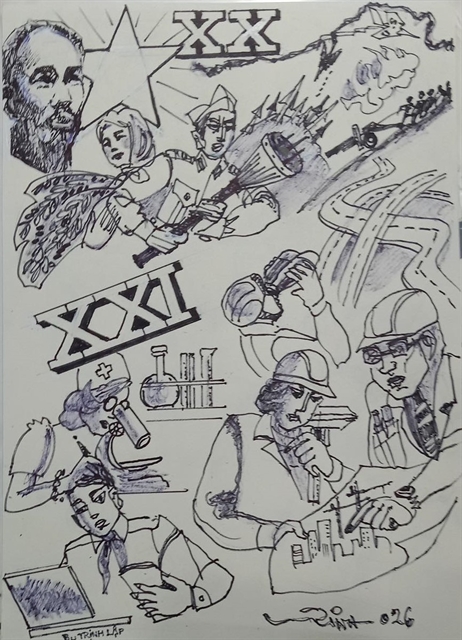 Talk Around Town
Talk Around Town

For many Vietnamese families, chicken is a favourite dish. However, at roughly VNĐ140,000-160,000 (US$6.2-7.1) per kilo, which is rather high compared to pork at about VNĐ100,000 (US$4.4) per kilo, housewives can hardly choose it as a regular dish on their dining table.
 |
For many Vietnamese families, chicken is a favourite dish. However, at roughly VNĐ140,000-160,000 (US$6.2-7.1) per kilo, which is rather high compared to pork at about VNĐ100,000 (US$4.4) per kilo, housewives can hardly choose it as a regular dish on their dining table.
Recently, the Animal Health Department under the Ministry of Agriculture and Rural Development has proposed to allow poultry and poultry products from China to be imported into Việt Nam. Chicken meat and one-day-old chicks will likely be imported officially and legally if the department gets the nod from the ministry.
The proposal is considered a way of opening up the poultry market to be more competitive. The price of poultry products will surely fall, and consumers will have more choices for their meals at more reasonable prices. However, whether this kind of imported chicken will be welcomed on Vietnamese dining tables is another story.
Although the department has committed to setting up criteria to strengthen control over imported chicken, consumers still have doubts about the quality of such legal imports.
Trần Minh Vân, housewife in Hà Nội’s Minh Khai Street, said she would say no to imported chicken, regardless of its origins.
“I don’t believe in packed poultry products. It might be from an ill or even rejected chicken, whether they are labeled from China or any other country,” she said.
“Moreover, I can’t tell between a legally imported chicken and a smuggled one.”
Vân said she only purchased domestically-raised chicken sold at the supermarket near her house.
“At least I feel more secure about the quality of chicken.”
Vân has her own point. Stories about the smuggling of bad quality chickens appear again and again in local newspapers and on social websites everyday. Hundreds of tonnes of low quality chickens transported on trucks via border gates to Việt Nam for consumption have been discovered annually. Many were rotten when found by authorised agencies.
Many consumers must have been scared by the story about rejected chicken being smuggled across the border at night, which made headlines in many newspapers last year. The discarded chicken was sold at VNĐ10,000-15,000 ($0.4-0.6) per kilo at the border with China, and then re-sold at VNĐ50,000-60,000 ($2.2-2.6) at Hà Nội’s wholesale markets. Tests showed that all samples of smuggled chicken had excessive antibiotic residue.
A crackdown on smuggled chicken at key wholesale markets in Ha Noi was carried out soon after that, and all contaminated products were culled. However, Hà Vĩ, Đại Xuyên and Ninh Hiệp markets have remained hot spots of smuggling that need to be inspected round-the-clock.
Đinh Thu Phương, a chicken seller in Hà Nội’s Yên Phụ Market, said that she was not worried that her customers would choose imported chicken instead of her products.
“Consumers have become more and more prissy and careful about the food they eat. They come to my shop because the chickens are raised on a farm in my hometown in Sơn Tây Town and they are all healthy”, she said.
“Imported chickens have been available at supermarkets for many years, but I can sell about 30 chickens per day, and several hundred chickens on worshipping days or Tết holidays.”
“The most important thing is they must be healthy, and are from disease-free places,” she said.
However, to assure poultry sold at the market is healthy is not a simple problem, and consumers have already lost trust in imported products once. Last September, consumers were frustrated after the Vietnam Poultry Association announced that US-imported chicken wings sold at supermarkets with were discarded.
The chickens had reportedly expired their use-by-date after a long period of being frozen, but they were brought to Việt Nam with falsified expiry dates for consumption at a very cheap price – about US$0.9 per kilo.
In the meantime, the management system over imported products remains weak, and a shortage of border guards, staff and police, and the small penalties for violations (a maximum of VNĐ100 million or US$4,500), are being blamed for the continuation of smuggling.
Consumers protect their health and safety by sharing information about bad quality food and how to distinguish good and bad quality food from blogs and social networks.
It’s hard to say that consumers will show interest and trust in the new imported chickens. The proposal, in my opinion, is not proper. I myself would rather choose domestic products. Until the management of imported products, especially food, is improved, I and other consumers can’t put our trust again in those products. — VNS




